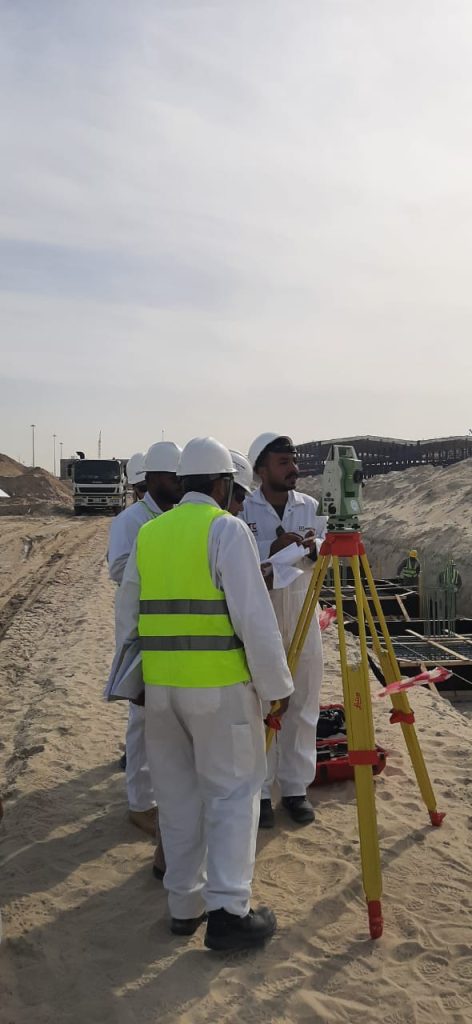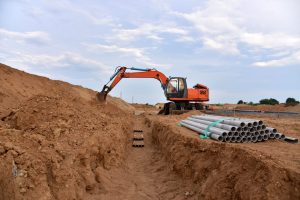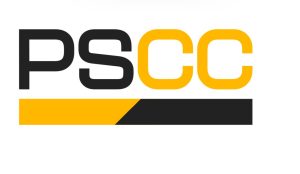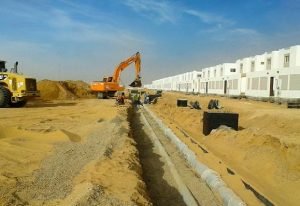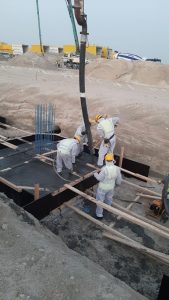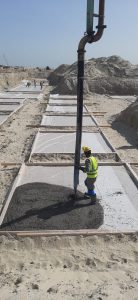Building with Concrete: A Comprehensive Guide to Finding and Hiring a Contractor in KSA
Introduction:
Concrete is a fundamental material used in many construction projects, from building foundations to bridges, roads, and high-rise buildings. It is a versatile and durable material that can withstand harsh weather conditions and heavy loads. In Saudi Arabia, the demand for concrete contractors has increased due to the construction boom in recent years. However, finding the right contractor for your project can be a daunting task, especially for those who are not familiar with the construction industry.
This book, Building with Concrete, is a comprehensive guide to help individuals and businesses find and hire the right concrete contractor for their project in Saudi Arabia. The book provides essential information about the construction industry in KSA, the types of concrete projects, and the qualities to look for in a contractor. It also includes practical tips for preparing and managing a concrete project and dealing with unforeseen circumstances.
In this book, readers will learn about the different types of concrete used in construction projects, such as ready-mix concrete, precast concrete, and site-mixed concrete. They will also learn about the essential qualities to look for in a concrete contractor, such as experience, certification, insurance, and a good reputation in the industry. Additionally, the book provides insights into the legal and regulatory requirements for concrete projects in Saudi Arabia.
Overall, this book aims to educate readers about the concrete construction industry in Saudi Arabia and help them make informed decisions when choosing a concrete contractor. It is a valuable resource for homeowners, business owners, construction professionals, and anyone interested in the construction industry.
Chapter 1: Introduction to Concrete Construction in KSA
Concrete is an essential building material used in many construction projects in Saudi Arabia. In this chapter, readers will learn about the history of concrete construction in KSA and its importance in the construction industry. The chapter also covers the different types of concrete used in construction projects, such as ready-mix concrete, precast concrete, and site-mixed concrete. Readers will learn about the advantages and disadvantages of each type of concrete and their suitability for different types of projects.
The chapter also covers the various applications of concrete in construction projects, such as building foundations, walls, columns, slabs, bridges, and roads. Readers will gain an understanding of the properties of concrete, such as its strength, durability, and resistance to weather conditions and chemical corrosion. They will also learn about the factors that affect the quality of concrete, such as mixing, curing, and finishing.
Finally, the chapter provides an overview of the construction industry in Saudi Arabia, including the major players in the market, the types of construction projects, and the trends in the industry. The chapter aims to provide readers with a broad understanding of the concrete construction industry in KSA and its significance in the construction sector.
Chapter 2: Finding the Right Concrete Contractor
When it comes to any construction project, finding the right contractor is essential. In this chapter, readers will learn about the qualities to look for in a concrete contractor and how to find the right one for their project.
The chapter starts by discussing the importance of experience in a concrete contractor. Experienced contractors have a wealth of knowledge and expertise in the field, making them better equipped to handle complex projects. Additionally, experienced contractors are more likely to have a good reputation in the industry, which can be a useful indicator of their reliability and quality of work.
Certification and insurance are also crucial qualities to look for in a concrete contractor. Certified contractors have completed the necessary training and have demonstrated their competence in the field, while insurance provides protection in case of any accidents or damages during the project.
The chapter also covers the different ways to find a concrete contractor, such as through referrals, online directories, and industry associations. Readers will learn about the advantages and disadvantages of each method and how to choose the best option for their needs.
Finally, the chapter discusses the importance of communication in the contractor selection process. Clear communication between the contractor and the client is crucial for a successful project, and readers will learn about the best practices for establishing effective communication with their chosen contractor.
Chapter 3: Preparing for a Concrete Project
Preparation is key to the success of any construction project, and concrete projects are no exception. In this chapter, readers will learn about the essential steps for preparing for a concrete project, including site preparation, project planning, and budgeting.
Site preparation is the first step in any construction project, and it involves ensuring that the construction site is suitable for the project. Readers will learn about the factors to consider when selecting a site, such as the soil conditions, drainage, and accessibility.
Project planning is another critical aspect of preparing for a concrete project. Readers will learn about the different stages of project planning, including project design, permitting, and scheduling. They will also learn about the importance of project management in ensuring that the project is completed on time and within budget.
Budgeting is also an essential part of preparing for a concrete project. Readers will learn about the factors that affect the cost of a concrete project, such as the type of concrete used, the size of the project, and the complexity of the design. They will also learn about the best practices for budgeting, including creating a detailed project budget and working with the contractor to manage costs effectively.
Overall, this chapter aims to provide readers with a clear understanding of the essential steps for preparing for a concrete project. By following these steps, readers can ensure that their project is completed successfully and within budget.
Chapter 4: Dealing with Unforeseen Circumstances
Despite careful planning and preparation, unforeseen circumstances can still arise during a concrete project. In this chapter, readers will learn about the common issues that can occur during a concrete project and how to deal with them effectively.
The chapter starts by discussing the importance of having a contingency plan in place. A contingency plan is a backup plan that outlines the steps to take in case of any unexpected issues during the project. Readers will learn about the different types of contingency plans, such as weather contingency plans and materials contingency plans.
The chapter then covers the common issues that can occur during a concrete project, such as weather delays, equipment malfunctions, and design changes. Readers will learn about the causes of these issues and how to address them effectively, such as rescheduling work, repairing equipment, or revising the project design.
Finally, the chapter discusses the importance of communication in dealing with unforeseen circumstances. Effective communication between the contractor and the client is crucial for addressing issues as they arise and finding solutions quickly.
By understanding the common issues that can occur during a concrete
project and having a contingency plan in place, readers can minimize the impact of these issues on their project and ensure that it is completed successfully.
Chapter 5: Concrete Mix Design
Concrete mix design is the process of determining the proportions of concrete ingredients to achieve the desired properties of the final product. In this chapter, readers will learn about the different factors that affect concrete mix design and how to select the right mix for their project.
The chapter starts by discussing the key properties of concrete, such as strength, durability, and workability. Readers will learn about the different factors that affect these properties, such as the type of cement used, the water-cement ratio, and the aggregate type and size.
Next, the chapter covers the different types of concrete mixtures, such as standard mixes, high-strength mixes, and lightweight mixes. Readers will learn about the advantages and disadvantages of each type and how to select the right mix for their specific project requirements.
The chapter also discusses the importance of testing and quality control in concrete mix design. Readers will learn about the different types of tests used to assess concrete quality, such as compressive strength tests and slump tests. They will also learn about the best practices for quality control, such as regular testing and inspection of the concrete during the project.
Overall, this chapter aims to provide readers with a comprehensive understanding of concrete mix design and how to select the right mix for their project. By following the guidelines in this chapter, readers can ensure that their concrete is of high quality and meets their project requirements.
Chapter 6: Reinforcement and Joint Design
Reinforcement and joint design are essential components of any concrete project. In this chapter, readers will learn about the different types of reinforcement and joint designs and how to select the right option for their project.
The chapter starts by discussing the importance of reinforcement in concrete projects. Reinforcement is used to improve the strength and durability of concrete structures, and readers will learn about the different types of reinforcement, such as rebar, wire mesh, and fiber reinforcement.
Next, the chapter covers the different types of joints used in concrete projects, such as contraction joints, expansion joints, and isolation joints. Readers will learn about the functions of these joints and how to select the right joint design for their project.
The chapter also discusses the importance of proper joint spacing and sealing in concrete projects. Proper joint spacing and sealing help to prevent cracks and other damage to the concrete structure, and readers will learn about the best practices for joint spacing and sealing.
Finally, the chapter covers the different methods for reinforcing and jointing concrete, such as doweling, epoxy, and mechanical connections. Readers will learn about the advantages and disadvantages of each method and how to select the right method for their project.
By understanding the importance of reinforcement and joint design and selecting the right options for their project, readers can ensure that their concrete structure is strong, durable, and free from damage.
Chapter 7: Formwork Design and Construction
Formwork is a temporary structure used to support and shape concrete during the curing process. In this chapter, readers will learn about the different types of formwork and how to design and construct formwork for their concrete project.
The chapter starts by discussing the importance of formwork in concrete projects. Formwork provides a temporary structure for the concrete during the curing process and helps to ensure that the final product is of high quality.
Next, the chapter covers the different types of formwork used in concrete projects, such as timber, steel, and plastic. Readers will learn about the advantages and disadvantages of each type and how to select the right formwork for their project.
The chapter also discusses the different factors that affect formwork design, such as the size and shape of the structure, the concrete mixture, and the site conditions. Readers will learn about the best

